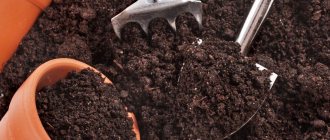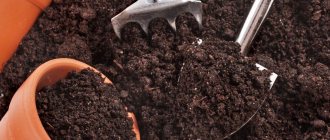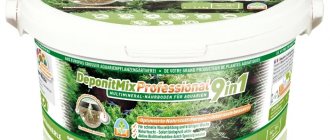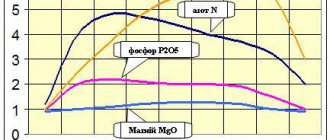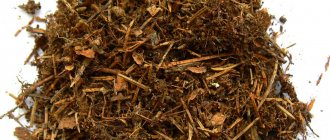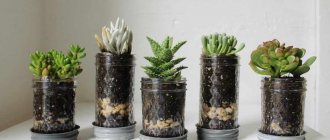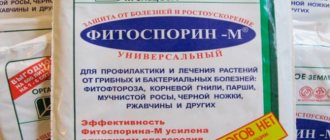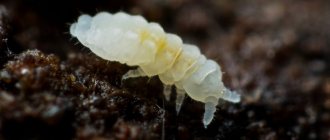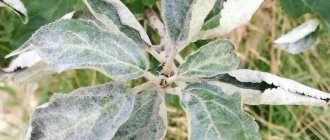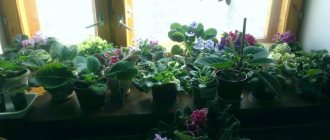Benefits of homemade soil
The quality of ready-made soil mixtures can often be called into question. At home, it is difficult to check whether the necessary requirements for the soil are met:
- percentage of components required by a particular plant;
- carrying out disinfection;
- acidity indicator.
Land for flowers
Moreover, experienced gardeners prefer to mix soil, not only based on the needs of the type of plant for which this soil is intended, but also based on its size, age, and conditions of detention.
Coniferous land
This soil is simply necessary for violets (Saintpaulias), gloxinias (Siningias), begonias and azaleas. Some gardeners grow these indoor plants in clean coniferous soil. I also had such experiments. But as a result, I still make soil mixtures for them, although their basis is coniferous soil. It is harvested, of course, in a coniferous forest. But not every coniferous forest (or forest area) is suitable for this. For the most part, the soil under the trees has a high sand content, which in itself is not scary, but you need land. So, what is here, you need to look.
How to make the perfect soil with your own hands
Pests of indoor plants and diseases of indoor flowers
You can prepare a good soil mixture at home from natural or purchased ingredients. In the first case, you will have to additionally check the acidity level of the soil, while on the packaging of store-bought mixtures the acidity level is indicated by the manufacturer.
Main soil components
Among the main components used in preparing soil for indoor plants are turf, coniferous, humus, compost, leaf soil, as well as peat and sand. In addition to these, there are other components that are mixed into the soil to improve its qualities:
- Perlite or vermiculite allows you to balance the composition, making it permeable to air and moisture.
- Coal is necessary to absorb excess moisture and as a preventive measure against certain pathogens.
- Chalk or lime replenishes the lack of calcium in the soil and reduces its acidity.
- Expanded clay, broken brick or clay shards are needed to create a drainage layer.
- Coconut fiber or bark is added to substrates for epiphytic plants and those that prefer loose soils.
- Sphagnum disinfects the soil and is able to retain moisture.
- Mole soil collected from mounds near animal burrows is good because it is completely cleared of weed seeds, insects and their larvae.
Components for soil mixture
How to disinfect flower soil
Soil brought from a garden or forest may contain microorganisms, bacteria or insect pests. Therefore, when mixing the soil yourself, you often cannot do without a disinfection procedure.
Garden soil can be treated with Fitosporin, Gamair or Alarin. This will destroy bacteria and fungal infections, making the composition comfortable for indoor plants.
Advice! You can resort to heat treatment, which comes down to two main methods: steaming in the oven at a temperature of at least 120 ⁰C and freezing (keeping on the balcony in winter).
Types of ready-made substrates
Gardeners conditionally divide soil types into 2 large groups: universal and specialized.
On the packaging of each you can always see for which plants the substrate is intended. For house flowers, you need to look for the “for indoor plants” label.
Also in stores you can see soil “for flowers and seedlings”, “for indoor and ornamental plants”, “for fruit and berry crops”. Some European manufacturers even sell special soil for growing mushrooms. True, there is no need to plant anything there. Just moisten the substrate and wait for the harvest.
Specialized substrates are suitable for one type of plant. Less often - for two or three at once.
For example, there is soil for violets, roses, conifers or cacti with succulents. The composition of such specimens is clearly adjusted in terms of acidity and consistency.
In addition to regular soil substrates, you can buy coconut substrates. The soil is ideal for growing flowers and seedlings, and is also suitable for transporting plants and temporary placement. Why is it not suitable for permanent placement? It's all about the amount of nutrients. There are almost none. For long-term nutrition of the root system, you need something richer.
Which manufacturers of soil for indoor plants are in demand?
Let's start right away with Russian names, since their products are affordable, familiar to domestic consumers for many years, and very widespread in all regions.
Peter Peat
is a large producer of peat substrates, nutrient soils and organic fertilizers. The company grew out of the fuel and energy complex, which began its activities back in the 50s. Now specialists are engaged in the extraction and processing of high-moor sphagnum peat with a low degree of decomposition, as well as lowland and transitional peats. The deposits are located in the Ryazan region and Karelia. So the peat for your flowers is also from these regions.
Agricola
is a commercial and industrial brand known throughout Russia. The parent company has been operating since 1996. Today it is engaged in the creation and sale of a wide range of soils/fertilizers for various crops. The company is included in the Plant Protection Association of the Russian Federation. Agricola products regularly participate in exhibitions and take prizes. The manufacturer has already won about 85 awards.
Pelgorskoe-M
is a Russian peat enterprise that offers customers planting soils under the Morris Green and Dobry Pomoshchi brands. The company's catalog contains about 19 different soil mixtures for pets and outdoor vegetation. The quality of the products meets European standards and has been awarded at various competitions (including a gold medal at an international exhibition).
It is also worth noting the products of Terra Vita, Garden Earth, Ecoss, ASB Greenworld, Sera.
The best universal substrates for indoor plants
Among the universal soils for plants, the product from ASB Greenworld stands out. Ornamental plants, seedlings, transplanted trees in the garden and even a lawn will be happy with the material. The substrate does not clump, accumulates well and releases minerals to the roots. Light and crumbly mass allows air to pass through well.
If we talk only about indoor flowers, the soil is suitable for begonias, violets, gerberas, camellias, phlox, daylilies, etc.
ASB Greenworld Universal Substrate is not suitable only for plants that like more acidic conditions.
In addition to such huge advantages as convenient dense packaging and a wide range of uses, soil also has disadvantages. Or rather, only one: rather large elements of wood chips. It is best to sift the substrate before work (just spill it through your hands) and remove very large elements. Otherwise, we recommend the soil for purchase.
We also recommend paying attention to Ecoss, Auriki Gardens, Peter Peat, Seliger-Agro, Terra Vita.
The best soil for violets
Gera soil is perfect for violets. This substrate can be purchased both for plants in pots and for flowers in open ground. Flowers that this soil is suitable for: Usambara violet (Saintpaulia), columnea, episcia, gloxinia, koleria, gesneria, streptocarpus, sinningia.
You can safely buy a large bag of Gera soil, since the remains after transplanting violets can be used for growing flower seedlings, top dressing on the soil of growing greenery, forcing bulbous seeds, or mulching (covering) the soil under plants.
Contains soil for flowers from the violet family:
- a mixture of peat of varying degrees of decomposition;
- processed river sand;
- lime flour (dolomite);
- sapropel extract;
- complex mineral fertilizer;
- potassium humate;
- vermiculite/agroperlite.
We also suggest paying attention to the soil from the company Agricola, Flower Paradise, Veltorf, Ecoflora, Fasco (Flower Happiness).
The best soil for orchids
For orchids, it is worth buying the Garden of Babylon substrate. This special mixture is very airy, which is very important for the root system of orchids. Indeed, in the wild, the base of these flowers is mainly located in the open air.
The special substrate contains screenings and coconut fibers, pieces of coniferous bark, a little expanded clay, expanded vermiculite, and cotton grass of high-moor peat.
Orchid soil contains a lot of nutrients because it contains very little soil per se. Wealth is manifested not only by the list of substances, but also by their content:
- from 0.3 to 0.9% nitrogen (N);
- up to 0.4% phosphorus (P);
- up to 0.3% potassium (K);
- up to 0.4 calcium (Ca);
- about 30% water (but not more).
All benefits for orchids are packaged in a plastic bag. The volume varies, but mostly on the shelves there is a gramme, which is enough for 1-2 medium pots.
We also recommend Peter Peat, Florika, Geolia soil for orchids. Zeoflora.
The best soil for roses
In Russia, especially in the southern regions, roses grow wonderfully. Moreover, there are more than a hundred different varieties. So domestic soil producers have a place to practice and create appropriate substrates.
One of the best Russian manufacturers of soil for roses is Agricola.
The product has already been assigned all the necessary quality certificates. The substrate has been on sale for quite a long time, so plant growers have had time to evaluate it and recommend it to their colleagues.
In short, the soil:
- universal for roses;
- accumulates fertilizer well and nourishes the root system;
- remains loose and nutritious for a long time due to the presence of high-moor peat (with it, air flows better to the roots and moisture is also retained);
- includes a standard mineral complex, which is also suitable for hybrid roses, chrysanthemums, quince or dahlias.
The soil contains peat, as well as nitrogen (NH4+NO3) – 200, phosphorus (P2O2) – 300, potassium (K2O) – 450 and pH salt suspension – 6.
If suddenly you don’t find Agricola in the store, pay attention to the products of Botanist’s Dream, Ecoflora,
Peter Peat .
Drawing the right conclusions
Flowers need to be grown in soil with the appropriate structure, composition and acidity level. Too acidic soil can kill a number of delicate houseplants, and vice versa. It is optimal to update the soil every one and a half to two years. There is no need to add fertilizing immediately after transplantation, since manufacturers saturate the material with all the necessary microelements.
Russian manufacturers are no worse at creating suitable substrates for indoor plants than foreign ones.
In addition, domestic goods are on most shelves. If for some reason they are not there, most likely the soil has simply been sold out. To prevent a trip to the store from being in vain, we recommend ordering products from online stores. For example, on Valles.ru . Everything is always available here. And if something is missing, the consultant will warn you about it in a timely manner and offer a similar option.
Main types of soil
Why do the leaves of indoor flowers turn yellow - what to do?
To mix soil that is suitable for growing a particular plant, you need to understand the qualities and properties of each type of soil. In this case, it does not matter at all whether the soil for indoor flowers was purchased or dug up with one’s own hands.
Light, medium and heavy soil mixtures
Although there is so-called "universal soil", it may not meet the needs of many plants grown in apartments. All soil mixtures should be divided into light, medium and heavy. Light soil mixtures are suitable for cacti and succulents. The light mixture consists of the following components:
- 4 parts peat;
- 2 parts of garden soil;
- 1 part of leaf or turf soil;
- 4 parts sand;
- a small amount of agroperlite, vermiculite, charcoal, drainage material.
Soil mixtures with a medium density composition are more versatile. They are used for growing decorative foliage and flowering plants in pots. The average mixture can be obtained by combining the following components in certain proportions:
- 4 parts peat;
- 3 parts of garden soil;
- 2 parts of turf land;
- 1 part compost or humus;
- 3 parts sand;
- some vermiculite and charcoal.
Preparation of earthen mixture
Heavy mixtures are recommended for large plants grown in tubs. These include tropical palms, vines, ferns, and azaleas. The composition of the heavy mixture is:
- 6 parts peat;
- 4 parts garden soil;
- 3 parts of leaf or turf soil;
- 2 parts sand;
- 2 parts compost or humus (can be replaced with vermicompost);
- additionally - bark, pine needles, sphagnum, charcoal.
Humus soil
This type of soil is created by mixing rotted manure with soil in a special hole or pile. A variety of this type of soil is vermicompost - the most fertile additive to soil mixtures for any indoor flowers. Essentially, this is the same humus, but produced using a humus worm.
Sod land
The type of soil taken from the place where various grasses grow is preferable - cereals or legumes, since such soil has the highest nitrogen content. However, the soil dug up from the top layer of the meadow is considered quite suitable.
Coniferous land
An acidic type of soil harvested where coniferous trees grow. Such soil is necessary for some indoor plants - for example, Saintpaulias, azaleas, gloxinias, begonias - as the main component of the soil mixture.
Leaf ground
The most ordinary forest soil or soil from a personal plot, taken from under a fruit tree, is very nutritious due to the rotted leaves it contains. It is often recommended to use leaf soil without other types of soil, only with the addition of a small amount of sand or perlite.
Sand
It is almost impossible to do without this component when preparing soil mixtures for various house flowers. Although sand does not have nutritional properties, it makes the soil looser and more permeable to moisture and air. However, it is worth considering that only river sand is suitable, and in no case construction sand.
Peat soil
Peat is the main component of finished soils, making them lighter and looser. Its disadvantage is that after it dries completely, it absorbs moisture very poorly, as a result of which watering the plant does not give the desired result - the water passes right through the substrate without staying in it.
Important! To prevent the plant from dying from drying out, it is advisable not to use this type of soil in its pure form.
Why is it better to buy a substrate than to prepare it yourself?
There are some geniuses who know where and how much to dig up land, where to add sand, bark or pine needles.
But to become such a professional, you need to study at the Faculty of Agriculture or have extensive experience with a number of failures. For most ordinary flower lovers, these are not methods. The only way not to destroy the flower is to buy a substrate for indoor plants. Those professionals mentioned above have nothing against such a decision. And all because there are several strong arguments in favor of buying ready-made soil:
- Substrate manufacturing teams employ specialists who calculate the balance of nutrients, minerals and other components for the flower. They accurately recreate the ideal habitat.
- Although park soil looks good, it is not what houseplants need. With such a base, you need to carry out several more operations to make a full-fledged substrate. Not a single indoor flower will feel comfortable in ordinary “wild” soil. Perhaps bulbous flowers like hyacinths, tulips, etc.
- There is a high probability that the soil in the city park is oversaturated with metals and toxins. There is no such thing in ready-made soil for flowers. The material is processed and sterilized.
- With ready-made soil for indoor plants, you don’t need to spend a lot of time. I just bought, mixed and planted a flower.
Soil acidity for indoor flowers
Soil for Dracaena - which one is needed and how to choose
Knowing which trees and flowers like acidic soil and which ones like neutral or alkaline soil, you can mix the soil suitable for them. Typically, peat soil is acidic, turf and leaf soil are neutral (pH 5.0 - 5.5) or have a slightly alkaline reaction, and clay soils are alkaline (pH 5.5-6.5).
Soil acidity for home flowers
What indoor flowers love acidic soil, list:
- azalea;
- aspidistra;
- bougainvillea;
- ginura;
- blueberry;
- hydrangea;
- dichorysandra;
- camellia;
- coffee;
- laurel;
- vines (gloriosa, passionflower, clerodendrum, hoya);
- oleander;
- palm trees (dracaena, coconut, Livistona, rapis, date, chamedorea, howea, cycas yucca);
- ferns;
- pelargonium;
- rhododendron;
- ficus;
- fuchsia;
- cyclamen;
- Sheffler.
List of plants that like alkaline soil:
- anthurium;
- balsam;
- begonia;
- gloxinia;
- dieffenbachia;
- calathea;
- croton;
- arrowroot;
- rhipsalidomsis;
- selaginella;
- Saintpaulia;
- syngonium;
- skirpus;
- spathiphyllum;
- scindapsus;
- Tradescantia;
- philodendron;
- fittonia;
- cissus;
- Schlumberger.
Plants adapted to neutral soil:
- abutilone;
- aloe;
- albizia;
- amaranth;
- ampelopsis;
- asparagus;
- aphelandra;
- brunfelsia;
- hibiscus;
- hippeastrum;
- dizygotheca;
- Kalanchoe;
- castanospermum;
- coleus;
- lemon;
- myrtle;
- milkweed;
- rose;
- sansevieria;
- sedum;
- syngonium;
- cineraria;
- eucalyptus.
Where can I get the right soil for seedlings?
You can, of course, buy ready-made soil for vegetables in the store - this is the easiest option. But it is unlikely that in this case we will be able to take into account the needs of each crop, which means we will not allow the seedlings to reveal their full potential. So it may be worth spending a little time and effort to provide optimal nutrition to our seedlings at a very early stage of development.
The main advantage of preparing the soil mixture with your own hands is saving money. Yes, this is a troublesome task: finding all the necessary components, making sure of their quality, mixing in the correct proportions is not as simple as it might seem at first glance. But anything is possible if you know exactly what ingredients you need and where to find them.
You should not take soil from the garden or vegetable garden to grow seedlings. Firstly, it most likely contains a minimum of nutrients, because... previous harvests have already “eaten up” all the most useful things. And secondly, the soil on the site may be contaminated with pests and pathogenic microbes.
Suitable soil for seedlings can be prepared by mixing the following components in different proportions:
- peat,
- humus,
- compost,
- river sand,
- perlite (vermiculite),
- sawdust,
- turf land,
- soil from under forest plants (alder, hazel, nettle).
The listed ingredients are “mined” in natural areas or purchased in garden stores (except for the last two). Read about the benefits of soil from the forest and how to take it correctly in our article Autumn: time to prepare soil for seedlings.
The components for the soil mixture can be prepared in the fall and stored separately until spring, when it is time to use them. Or mix all the parts and keep the prepared soil in bags right on the street or in an unheated shed - a frosty winter will be an excellent disinfecting measure in this case. In the spring, before use, you will need to bring the soil into a warm room, let it thaw, sift and distribute it into containers.
The soil for seedlings should not contain actively decomposing elements - plant residues, fresh compost and “fertilizers” such as tea leaves. During the decomposition process, all these substances greatly increase the temperature of the soil, which has a detrimental effect on the roots of young, immature plants.
How to make acidic soil at home
There are several ways you can increase soil acidity at home. Loose soil is acidified by adding a significant portion of organic matter: compost, pine needles or sphagnum. Among mineral compounds, colloidal sulfur can be used.
Acidification of soil with citric acid
You can also acidify the soil mixture for indoor plants using improvised means. For example, how to acidify the soil with citric acid? To do this, take citric acid at the rate of 1-2 teaspoons per 10 liters of water, and pour this solution over the substrate.
To successfully grow various plants in an apartment, especially those coming from tropical places, it is imperative to take into account their needs for the composition of the soil. By learning how to properly mix the soil and acidify it, you can grow almost any plant on your windowsill.
Additional components
As was said at the beginning, all components of a multi-component soil for indoor plants fall into the categories of basic and additional.
Additional components are not required in the soil mixture, but can significantly improve the quality of the soil, and at the same time help the plant remain healthy and strong.
Most recommended by experts as additional ones for creating a high-quality soil mixture:
- horn meal - These are the horns and hooves of cattle crushed into powder, which in this form have proven themselves to be excellent as a phosphorus fertilizer. You may also come across horn shavings, but their action is slower, and therefore flour is preferable for indoor plants. It can be used both in dry form - added to the soil at a rate of 1:30, and (less often) in liquid form - soak 1 kg of flour in 1 liter of water.
- sphagnum - a substance close to peat, moss that grows in swamps. It is from sphagnum that high-moor (as we remember, acidic) peat is formed. Other names: sphagnum moss, peat moss. Loosening the soil, at the same time it is able to retain moisture in it. And since it has a low pH value - only 4, it contributes to the oxidation of the soil to a certain extent.
- wood ash - on the contrary, when added to the soil, it reduces its acidity, therefore it is also used as a regulator of this indicator. And also - as a potassium fertilizer. In addition to potassium, it contains iron, phosphorus, magnesium and other microelements beneficial for plants. Like horn flour, it can be added to the soil in dry form, but in a ratio of 1:50, or in liquid form - water the plant every 10-14 days with a composition of 25 grams. (or 3 tablespoons) of ash, infused for a week in 1 liter of water.
- charcoal - an excellent “doctor” for plants: in case of rotting of the roots, it is added in small quantities to the soil during plant replanting, and it is also sprinkled on wounds on any parts of the plant. Charcoal also helps loosen the soil and increases its moisture permeability. It is sold in the “flower” departments of stores, however, in the absence of a special one, charcoal for grilling is also suitable, but it will need to be crushed into small (up to 1 cm) pieces. In the most extreme case, charcoal, like ash, can be burned yourself.
- conifer bark - a desirable soil additive for orchids, epiphytes, ferns and anthuriums. Usually prepared on its own. To do this, the bark in the required amount is removed from old pines or spruces, crushed and pre-boiled for half an hour in water. Then it is added to the soil mixture.
Read also Bordeaux mixture. Composition, preparation, tips for use
Classification of ready-made soils
- Lightweight - consists of leaf and turf soil, crushed polystyrene foam, greenhouse soil, sand. This substrate is suitable for growing plants with a small root system, such as cyclamen and begonias.
- Medium - consists of leaf and turf soil, humus. Suitable for growing ficus and citrus fruits.
- Heavy - consists of turf soil, humus, coarse sand. Suitable for growing palm trees, clivia, dracaena, crinum.
Based on high-moor peat (decomposed sphagnum moss that grows in high bogs) - it contains a minimal amount of minerals, is breathable, has good water absorption and moisture retention. This substrate is often used as temporary soil when transporting plants, as well as for selling potted plants.
Based on lowland peat (extracted from lowland swamps, lakes and rivers) - it is characterized by the presence of a large amount of minerals and retains moisture well. However, it cakes quickly, takes a long time to dry out, and as a result, plant roots often rot. Soil based on lowland peat is used as a component of a soil mixture prepared independently, but not as an independent substrate.
Based on vermicompost (a product of manure processed by earthworms) - rich in organic substances and living organisms. Such soil is used as a component of the soil mixture to enrich it. Vermicompost is an alternative to humus.
What to look for when choosing ready-made soil
Priming:
- must allow air to pass through;
- must be nutritious;
- should not retain moisture for a long time;
- must not contain pests or pathogens;
- The acidity of the soil must correspond to the level needed by a particular plant species.
Similar articles:
- Kits for growing plants and flowers
- Bouquet for wedding
- Soil for azaleas
- Flowers for the balcony
- Window sill stands for flowers
- How to extend the life of a bouquet
